#triumphal quadriga
Text

The Horses of St Mark’s Basilica, Venice
The horses were placed on the facade, on the loggia above the porch, of St Mark's Basilica in Venice, northern Italy after the sack of Constantinople in 1204. They remained there until looted by Napoleon in 1797 but were returned in 1815. The sculptures have been removed from the facade and placed in the interior of St Mark's for conservation purposes, with replicas in their position on the loggia.
It is certain that the horses, along with the quadriga with which they were depicted, were long displayed at the Hippodrome of Constantinople; they may be the "four gilt horses that stand above the Hippodrome" that "came from the island of Chios under Theodosius II" mentioned in the 8th- or early 9th-century Parastaseis syntomoi chronikai. They were still there in 1204, when they were looted by Venetian forces as part of the sack of the capital of the Byzantine Empire in the Fourth Crusade. The collars on the four horses were added in 1204 to obscure where the animals' heads had been severed to allow them to be transported from Constantinople to Venice. Shortly after the Fourth Crusade, Doge Enrico Dandolo sent the horses to Venice, where they were installed on the terrace of the façade of St Mark's Basilica in 1254. Petrarch admired them there.
In 1797, Napoleon had the horses forcibly removed from the basilica and carried off to Paris, where they were used in the design of the Arc de Triomphe du Carrousel together with a quadriga.
In 1815 the horses were returned to Venice by Captain Dumaresq. He had fought at the Battle of Waterloo and was with the allied forces in Paris where he was selected, by the Emperor of Austria, to take the horses down from the Arc de Triomphe du Carrousel and return them to St Mark's in Venice. For the skillful manner in which he performed this work the Emperor gave him a gold snuff box with his initials in diamonds on the lid.
#horses#bronze#st mark’s basilica#venice#venetian#fourth crusade#sack of constantinople#constantinople#crusaders#classical antiquity#sculptures#classical greek#history#europe#european#hippodrome#napoleon#horses of saint mark#triumphal quadriga#horses of the hippodrome of constantinople#northern italy#republic of venice#crusades
163 notes
·
View notes
Text


A silver cup portraying the triumph of future emperor Tiberius. One side shows Tiberius in a triumphal chariot pulled by four horses (quadriga), and the other side shows a bull being sacrificed.
The cup is part of the so-called Boscoreale treasure, a collection of ancient Roman silverware discovered in a villa near Pompeii and buried by Vesuvius in 79 AD.
The reliefs on the cup are probably a copy of an existing monument that didn't survive.
244 notes
·
View notes
Text

Didrachm of the Roman emperor Claudius (r. 41-54 CE), found at Caesarea in Cappadocia (modern Türkiye). This coin was struck to commemorate Claudius' invasion and (partial) conquest of Britain in 43. On the obverse, the bust of Claudius, crowned with laurel. On the reverse, the emperor drives a triumphal quadriga (four-horse chariot), with the inscription DE BRITANNIS (From the Britons) below. Photo credit: Classical Numismatic Group, Inc. http://www.cngcoins.com
#classics#tagamemnon#ancient history#Ancient Rome#Roman Empire#Roman history#Julio-Claudian#Emperor Claudius#art#art history#ancient art#Roman art#Ancient Roman art#Roman Imperial art#coins#ancient coins#Roman coins#Ancient Roman coins#didrachm#numismatics#ancient numismatics
60 notes
·
View notes
Text

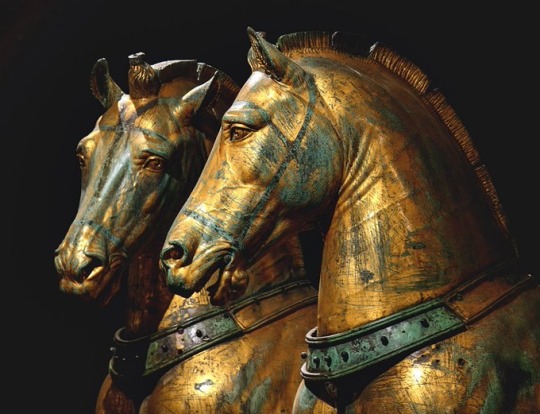


Triumphal quadriga, taken from the Hippodrome during the sack of Constantinople, 1204. Now located inside St. Mark’s Basilica in Venice
#fourth crusade#aka the robber’s crusade#i was going to say the murder crusade but that’s kinda all of them isn’t it?#byzantine#constantinople#roman art#byzantine art#these horses are virgos#rome#statue#bronze statue#cast bronze#but really dirty copper
113 notes
·
View notes
Text
Coins of the 12 Caesars: Titus
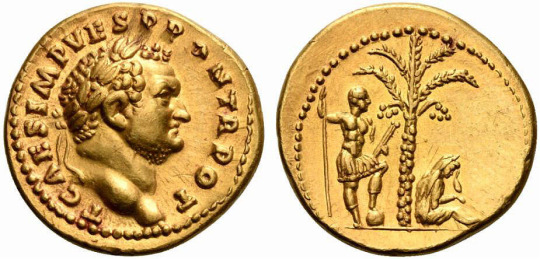
Titus, aureus struck in 71 or 72, during his tenure as Caesar under his father Vespasian.
Obverse depicts Titus facing right.
Legend reads "T CAES IMP VESP PON TR POT"
Reverse is a "Judaea Capta" type, depicting a Jewish woman seated and mourning to the right of a palm tree, to the left is Titus, holding scepter and parazonium with his foot resting on a globe.
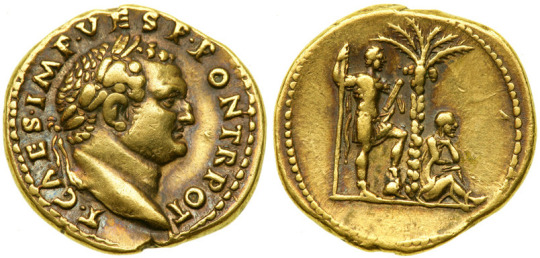
Same type as above, but this one has toning indicative of this coin being a part of the Boscoreale hoard found in Pompeii, with said toning being caused by the heat of the volcanic eruption.
Out of the Flavian dynasty's coinage I'd say Titus just barely takes second to Vespasian in terms of interesting coin types, only because I think Vespasian had the benefit of having more time to strike cool coins.

Sestertius of Titus as Caesar, struck in 72 AD.
Obverse depicts Titus facing right.
Legend reads "T CAESAR VESPASIAN IMP III PON TR POT II COS II
Reverse depicts Titus in a triumphal quadriga holding scepter and olive branch, the side of the quadriga depicts Titus putting his hand on the head of a captive, his other hand holding a palm branch..
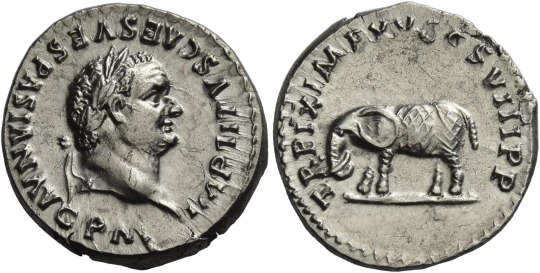
This is an interesting type; the reverse depicts an elephant as a commemoration of the inaugural games held at the Flavian Ampitheater (the colosseum). Elephants such as the one on this coin would have been brought in for entertainment.

The famous Colosseum sestertius, struck between 80 and 81 AD.
Obverse depicts the newly completed colosseum in the center, the Meta Sudans fountain to the left, and a porticoed building to the right.
Reverse depicts Titus seated on a curule chair surrounded by a pile of arms, holding a branch.
Legend reads "IMP T CAES VESP AVG PM TR P P P COS VIII
#ancient coins#ancient rome#ancient art#ancient history#roman art#roman history#roman empire#aureus#history#Titus
18 notes
·
View notes
Text






Horses of Saint Mark
The traditional theory attributes the sculptural group to the sculptor of the 4th century BC, Lysippos, thanks to its plasticity and natural body movement.
However, studies in its material showed that the horses are mostly from copper (which is best for gilding) and their processing with the techique of the lost wax in a monumental size suggests a later date to 2nd or 3rd AD. They might have been on the top of a triumphal arch, while it's possible they were comissioned by Emperor Septimus Severus.
During the Byzantine Era, written sources indicate that the horses adorned Constantinople's Hippodrome among many statues from around the world including an egyptian obelisk and a serpent column. As the chariot races' hallmark, the horses must have been exceptionally impressive when shining thanks to their gilding.
In 1204, during the Last Crusade, the Crusadors plundered Constantinople. At Doge Enrico Dandolo's command, the Venetians took the horses in Venice. Since their heads had been cut off for the transportation, collars were added to hide the reparation's scar. However, it wasn't until 50 years later, after Doge Ranieri Zeno's initiative, that the horses were put in the loggia on the façade of San Marco.
The horses inspired artists, such as Gentile Bellini, and drew the curiosity of the scholars, like Petrarch, who were the first to wonder about their origin.
In 1797, they were looted by Napoleon's army and were installed along with a quadriga on the Arc Du Triumph Du Carousel, in Paris. The horses on the Arc today are exact copies.
In 1815, the horses were victoriously restored to San Marco. The horses we see on he façade today are copies, as the original are transferred inside the basilica for protection.
In conclusion, despite not knowing their origins with certainity, the horses have made a story for themselves. Whether they honor a Roman Emperor, symbolize the momentum of the chariot races or mark the glory of Venice or France, these beautiful horses have never stopped stimulating our imagination.
#horses#san marco horses#san marco#saint mark#venice#hippodrome horses#hippodrome#byzantine history#byzantine#byzantium#crusades#4th crusade#napoleon#statue#lysippos#sculpture#art#arc du triumph du carousel
157 notes
·
View notes
Text
The Horses of Saint Mark
... or should I say, Chios? Constantinople, at least?
We often talk extensively about the looted Parthenon marbles that are currently exhibited in the British Museum, however there are hundreds of thousands of Greek artifacts illegally taken to western monuments, museums and universities.
One example is the very famous Horses of Saint Mark, also known as the Triumphal Quadriga, that can be seen on the fascade of Saint Mark's Basilica in Venice.

These horses used to decorate the Hippodrome of Constantinople and they were looted and sent to Venice, after the Sack of Constantinople by the Crusaders in 1204.
The exact date of their creation is unclear. They may date to the 1st-3rd century AD or they are older, dating to Classical Greek antiquity, and they are attributed to the 4th Century BC sculptor Lysippos. These horses may be the "four gilt horses that stand above the Hippodrome" that "came from the island of Chios island under Theodosius II" mentioned in the 8th- or early 9th-century Byzantine Greek text Παραστάσεις σύντομοι χρονικαί (Parastásis sýntomi chronikaé -Brief Chronicles).
As there has been no ending to the looting fate of these horses, they were also looted by Napoleon in 1797 who used them to decorate the Arc de Triomphe in Paris. However, they were returned to Saint Mark's Basilica in 1815.
In the 80s, the air pollution had started taking its toll on the ancient horses. Nowadays, the horses on St Mark's fascade are exact replicas, while the originals are displayed in the interior of the basilica.
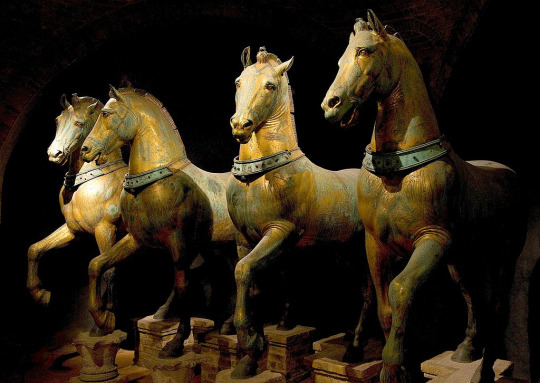
The horses of Constantinople, possibly originally from Chios island.
The collars were added later, to hide the spot were the statues were cut off, so that the statues could be transferred easily from Constantinople to Venice.
#horses of st mark#greece#chios#constantinople#venice#byzantine empire#ancient greece#greek history#istanbul#greek culture#northeastern aegean#greek islands
59 notes
·
View notes
Text
Saint Mark’s Basilica

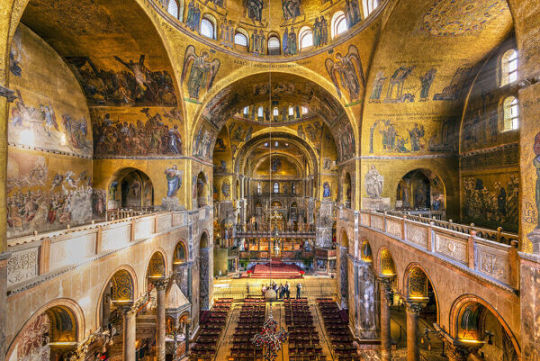


Saint Mark’s Basilica is located in Venice, Italy. It was built from 828-832 AD in an Italo-Byzantine design to house the remains of St. Mark. The basilica was destroyed by fire in 976 during a revolt against Pietro Canadiano IV and restored under his successor, Doge Domenico Contarini. From 1063-71 construction was conducted on the new basilica to represent the prosperous Venetian Republic. St Mark’s Basilica became the city’s cathedral in 1807 and continues to be the most important religious temple in Venice. The structure has a Greek cross base with five large cupolas symbolizing God’s presence according to the eastern model. The Byzantine domes give the structure a grandiose appearance. The basilica was altered and modified several times throughout its history, with pointed Gothic arches added, along with sculptures, mosaics, and marbles. The church combines architectural and art styles while preserving much of the original oriental aspects. The interior boasts more than five hundred 3rd century columns and 4,000 square meters of ceiling mosaics made of gold leaf infused glass, many from the 13th century. The Pala d’Oro altarpiece has over 2,000 gems, including emeralds, rubies, sapphires, and pearls. The treasury of the basilica has over 283 pieces of gold, silver, and objects from Islamic Art, including sculpted crystal lamps and the Triumphal Quadriga, a set of bronze horse sculptures located on the façade. Saint Mark’s Basilica and museum are open to the public.
#st mark's basilica#saint mark's basilica#Italy#venice#churches#museum#basilica of san marco#church of gold
10 notes
·
View notes
Text


The Carrousel triumphal arch, entrance to the Tuileries Palace under Napoléon IV
This construction took me about 3 hours to complete. I propose you below my construction little by little, for those interested! Let me know if you like the concept. I'll be able to show more in the future!
I based myself on the comparative visual, and also on the wonderful arc of @ardazek ! As I build my palace in the future, I will certainly add details to the structure. Also, I wanted to insert more images and txt but Tumblr limits me :c

1 - I prepared the triumphal arch with 3 floors of construction. I tested several columns and arches. To allow access to the middle arch, I simply broke down the walls of the 1st and 2nd floors. As on my Napoleon III era designs, I added a black and gold grid !


2 - I add the marble that comes with the Restaurant pack. Then a partition above (Florence pack from Felixandre). Finally, the passages on all sides of the arch and inside!
With the T key, I switch to top view to install the arches inside. Then I simply put a wall on top to fill the holes in the structure.


3 - After adding paintings to give the effect of bas-reliefs, I continued to give relief to the structure. Columns and a Doric base on each right angle, etc. I also added lights on the gold and black grid.
Then, finally, I installed the main sculptures. I created a platform at the top of the triumphal arch to accommodate the bronze quadriga and the four stone Minerva.
Finally, I added (and am still adding) details. As my space is going to support a whole pavilion of my Tuileries palace, I try not to put too many details so that my game doesn't crash. You have to find the right balance. Regularly, I switched to camera mode to test my future screens. :) This allows me to work on all angles of view!
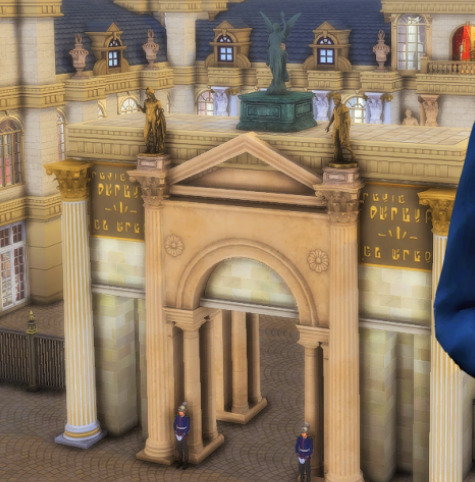
Bonus: my first version from last year...
44 notes
·
View notes
Photo

Chariot. Art by Sophie McKay Knight, from The Painted Tarot.
I painted this piece after being in Venice - the four horses in my painting are based on the Roman bronze ‘Triumphal Quadriga���, the iconic sculpture on top of Basilica San Marco in St Mark’s Square. In traditional decks, the Charioteer is more stationary (and is a man), but I wanted to feel the speed of a racing chariot through a moonlit night, looking only forward and never back. I was also thinking of the legendary strength and valour of the Roman Celtic Queen, Boudicca. If the Chariot comes up in a reading, it can signify determination, focus and drive - you are ready to take action on your decisions and there’s no time like the present!
2 notes
·
View notes
Photo
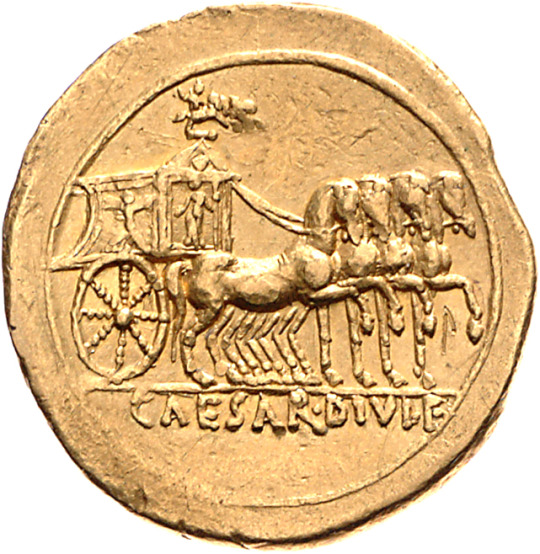
Roman triumphal quadriga
* CAESAR DIVI F
* 32-27 BCE
* minted (probably) in Brindisi
* discovered at Engter (near Osnabrück)
* Münzkabinett , Berlin
178 notes
·
View notes
Photo


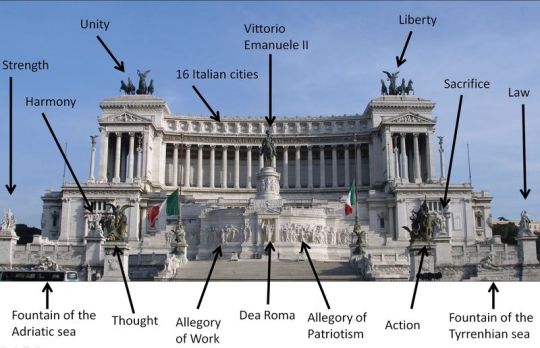

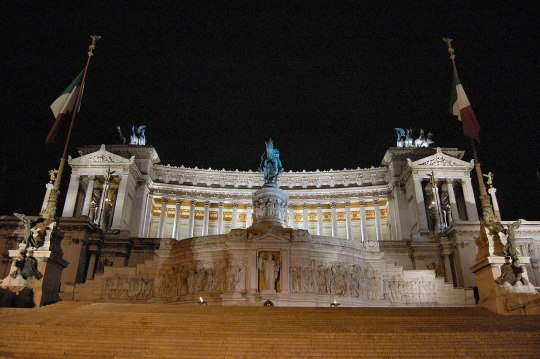


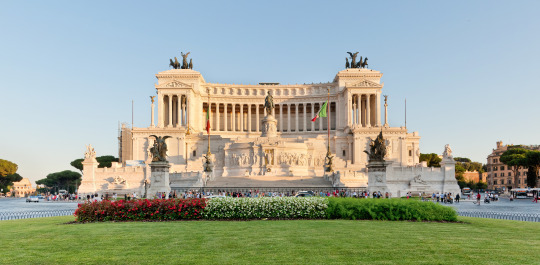
Rome: Victor Emmanuel II Monument
The Victor Emmanuel II National Monument (Italian: Monumento Nazionale a Vittorio Emanuele II) or (mole del) Vittoriano, called Altare della Patria (English: Altar of the Fatherland), is a national monument built in honour of Victor Emmanuel II, the first king of a unified Italy, located in Rome, Italy.[2] It occupies a site between the Piazza Venezia and the Capitoline Hill. It is currently managed by the Polo Museale del Lazio and is owned by the Ministry of Cultural Heritage and Activities.
From an architectural perspective, it was conceived as a modern forum, an agora on three levels connected by stairways and dominated by a portico characterized by a colonnade. The complex process of national unity and liberation from foreign domination carried out by King Victor Emmanuel II of Savoy, to whom the monument is dedicated, has a great symbolic and representative value, being architecturally and artistically centred on the Italian unification—for this reason the Vittoriano is considered one of the national symbols of Italy.
It also preserves the Altar of the Fatherland (Italian: Altare della Patria), first an altar of the goddess Rome, then also a shrine of the Italian Unknown Soldier, thus adopting the function of a lay temple consecrated to Italy. Because of its great representative value, the entire Vittoriano is often called the Altare della Patria, although the latter constitutes only a part of the monument.
Located in the centre of ancient Rome, and connected to the modern one by the streets that radiate from Piazza Venezia, it has been consecrated to a wide symbolic value representing a lay temple metaphorically dedicated to a free and united Italy—celebrating by virtue the burial of the Unknown Soldier (the sacrifice for the homeland and for the connected ideals).
30 sculptures on Italy’s birthday monument
Vittoriano plan
Vittoriano entrance with artistic gate by Manfredo Manfredi;
Sculptural group The Thought by Giulio Monteverde;
Sculptural group The Action by Francesco Jerace;
Adriatic Fountain by Emilio Quadrelli;
Sculptural group The Force by Augusto Rivalta;
Sculptural group The Concord by Lodovico Pogliaghi;
Tyrrhenus Fountain of Pietro Canonica;
Sculptural group The Sacrifice by Leonardo Bistolfi;
Sculptural group The Right by Ettore Ximenes;
A statue on the side of the sculptural group
Winged Lion by Giuseppe Tonnini;
Entrance stairway;
Winged Victory on naval ram by Edoardo Rubino;
Winged Victory su naval ram by Edoardo De Albertis;
Tomb of the Italian Unknown Soldier;
Statue of Goddess Rome by Angelo Zanelli;
Statues of fourteen Italian noble cities by Eugenio Maccagnani;
Equestrian statue of Victor Emmanuel II by Enrico Chiaradia;
Winged Victory on triumphal column by Nicola Cantalamessa Papotti;
Winged Victory on triumphal column by Adolfo Apolloni;
Propylaeus with colonnade on top of which is present
the Quadriga of Unity by Carlo Fontana;
Winged Victory on triumphal column by Mario Rutelli;
Winged Victory on triumphal column by Cesare Zocchi;
Propylaeus with colonnade on top of which is present
the Quadriga of Freedom by Paolo Bartolini;
Portico with colonnade whose upper cornice is decorated
rom the statues representing the regions of Italy. In front of
stylobate, towards the equestrian statue of Victor Emmanuel II ,
there is a terrace of the cities redeemed.
https://en.wikipedia.org/wiki/Victor_Emmanuel_II_Monument
https://www.italybeyondtheobvious.com/monument-to-vittorio-emanuele-ii-in-rome-italys-birthday-monument
16 notes
·
View notes
Photo
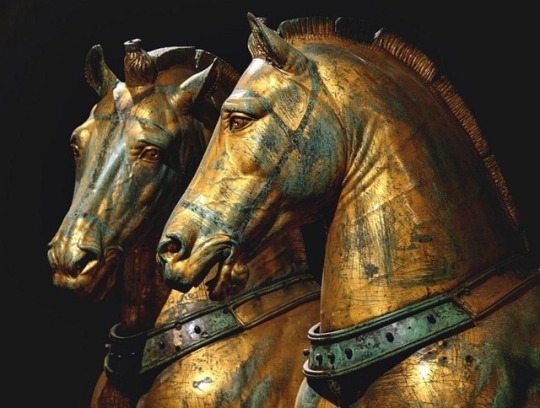
The Horses of Saint Mark, also known as the Triumphal Quadriga, were placed on the facad, on the loggia above the porch of St. Marks Basillica in Venice, after the sack of Constantinople in 1204. They are spectacular!
207 notes
·
View notes
Text
FORUM ROMANUM III

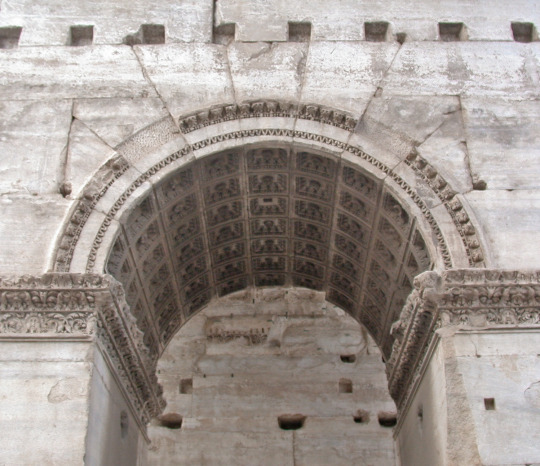
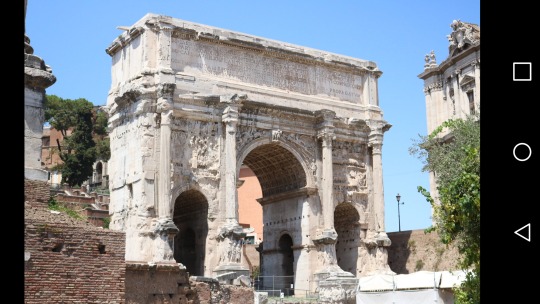
THE ARCH OF SEPTIMIUS SEVERUS
To consolidate his position as emperor, Septimius Severus undertook a military campaign against an array of barbarian triges and rivals to the throne in A.D. 194/195, which concluded with the capture of major Parthian cities. In recognition of these victories, the senate voted a triumph and a triumphal arch for the emperor and his two sons, Antoninus, better known as Caracalla, and Geta. The Severans returned to the east to defend the recent Roman conquests in 197/98.
Completed in A.D. 203, he triumphal arch stands next to the terminus of the Via Sacra on what was one of the last parcels of open land in the Forum Romanum. The arch was the last arch built in the Forum and was the last monument subsequent triumphators would pass on their way to the Capitoline Hill.
Like the arch of Trajan at Ancona, the arch of Septimius Severus is approached by a flight of stairs. The 3-bay structure stands on a travertine base and rises 21 m from the foundation. Proconnesian, Pentelic, and Luna (Carrara) white marble panels enclose a brick and travertine core. The outer bays are accessible from the central bay by transverse arches in the piers. The attic is divided into 4 chambers, reached by a staircase in the south pier. The arch of Septimius Severus is the earliest surviving arch to use detached columns, a feature first used on an Antonine arch that no longer survives.

The Severan arch was designed to echo another monument in the forum, notably the (now lost) “Parthian” Arch of Augustus, which straddled the Via Sacra near the Temples of Castor and Pollox and the Vestal Virgins. As the first triple bay arch (confirmed by numismatic evidence and excavation) raised in honor of Augustus' recovery of the standards from the Parthians in 20 BC, the Arch of Augustus served as a fitting pendant for the later arch. The formal echoing of the two arches proclaims the continuity of imperial power.
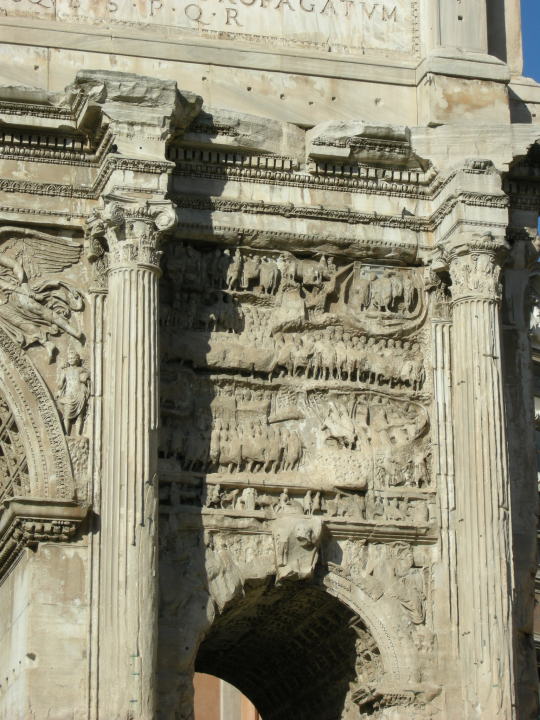
Originally, the arch was surmounted by a bronze sculpture of Severus and his sons riding in a horse-drawn quadriga (as they had during the actual triumph). Panels of relief sculpture depicting the besieging and capture of four cities in the Parthian wars occupy the area above the lateral arches. A frieze depicting the triumph of AD 195 is appended below those panels. Victories and captive barbarians fill out the program. The historical scenes depict events of the first campaign. No reference is made to the second campaign.
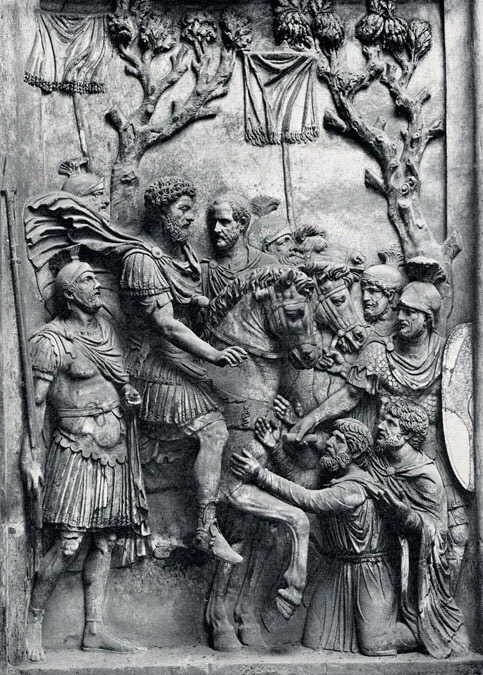
above: Clementia relief from the arch of Marcus Aurelius, c. AD 170, Rome, Musei Capitolini.
While the extensive sculptural program has precedents in previous arches, the style of exposition differs greatly. The reliefs from the (now lost) arch of Marcus Aurelius follow the Greek convention of monumental figures acting in a single scene unified by a common groundline and seen from a single point of view. The Severan reliefs, however, consist of a sequence of unframed scenes, filled with numerous smaller figures who stand on multiple groundlines, each with its own implied point of view.
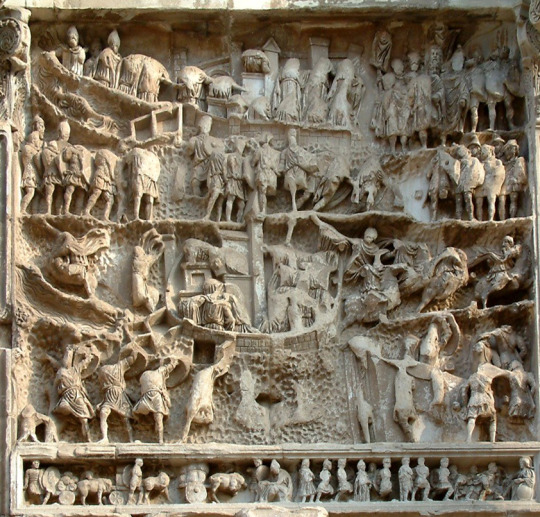
Relief Arch of Septimius Severus
The use of continuous narrative for the representation of a historical subject set on multiple curved and sloping groundlines suggests that the sculptors of the Severan reliefs based their work on the columns of Trajan (c. AD 112) and Marcus Aurelius (c. AD 180). Whether that technique can be transposed successfully from a curving helix to a flat rectilinear surface has been a matter of debate. The figure style closely resembles that of the later column. As the prolix inscription on the attic makes clear, the fiction of Antonine ancestry was critical to Severan political self-fashioning. The decoration of the arch supported that strategy by imitating the artistic forms of the previous generation.
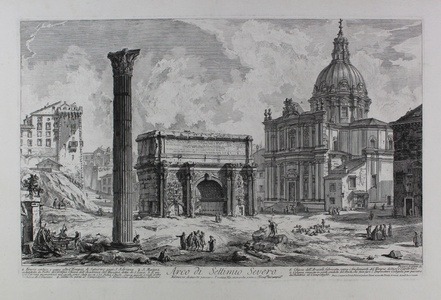
As the famous etching of the Forum Romanum by Piranesi shows, by 1765, the groundline of the area had risen 5 meters leaving only the upper half of the Arch of Septimius Severus visible. Excavation of the arch began in 1520 and was largely completed by 1895, although the foundations were only exposed in the 1950s.
#classical antiquity#roman architecture#rome#septimius severus#caracalla#geta#julia domna#palmyra#leptis magna#triumphal arch#piranesi#forum romanum
45 notes
·
View notes
Photo

The Brandenburg Gate is an 18th-century neoclassical monument in Berlin, built on the orders of Prussian king Frederick William II after the temporary restoration of order during the Batavian Revolution. . . The Brandenburg Gate has played different political roles in German history. After the 1806 Prussian defeat at the Battle of Jena-Auerstedt, Napoleon was the first to use the Brandenburg Gate for a triumphal procession, and took its Quadriga to Paris. . . After Napoleon's defeat in 1814 and the Prussian occupation of Paris by General Ernst von Pfuel, the Quadriga was restored to Berlin. It was now redesigned by Karl Friedrich Schinkel for the new role of the Brandenburg Gate as a Prussian triumphal arch. The goddess, now definitely Victoria, was equipped with the Prussian eagle and Iron Cross on her lance with a wreath of oak leaves. . . When the Nazis ascended to power, they used the gate as a party symbol. The gate survived World War II and was one of the damaged structures still standing in the Pariser Platz ruins in 1945 (another being the Academy of Fine Arts). The gate was badly damaged with holes in the columns from bullets and nearby explosions. One horse's head from the original quadriga survived, and is today kept in the collection of the Märkisches Museum. . . . . . . . . . . Source: Wikipedia.org . . . . . . . #history #medieval #medievalhistory #medievalarchitecture #medieval #middleages #medievalart #historybooks #history360 #historicalarchitecture #berlin #brandenburg #brandenburggate #bookstagram #books #book #europe #architecture (at Brandenburg, Germany) https://www.instagram.com/p/B988osenx3W/?igshid=egxofnphmh8t
#history#medieval#medievalhistory#medievalarchitecture#middleages#medievalart#historybooks#history360#historicalarchitecture#berlin#brandenburg#brandenburggate#bookstagram#books#book#europe#architecture
2 notes
·
View notes
Photo
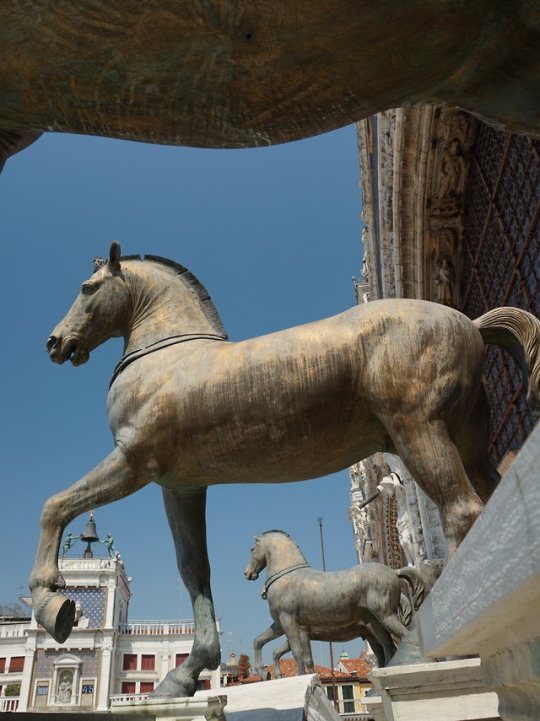
Replica of Byzantine hippodrome (it was in Istanbul) horses. The Horses of Saint Mark also known as the Triumphal Quadriga, Venice
3 notes
·
View notes